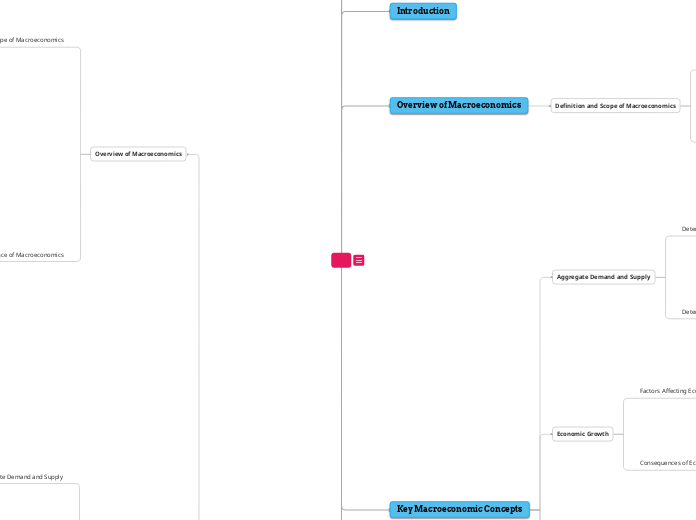Introduction
Overview of Macroeconomics
Definition and Scope of Macroeconomics
Study of Aggregate Economic Variables
Gross Domestic Product (GDP)
Unemployment Rate
Inflation Rate
Analysis of Economic Performance
Economic Growth
Business Cycles
Stabilization Policies
Key Macroeconomic Concepts
Aggregate Demand and Supply
Determinants of Aggregate Demand
Consumption
Investment
Government Spending
Net Exports
Determinants of Aggregate Supply
Labor Force
Capital Stock
Technological Progress
Economic Growth
Factors Affecting Economic Growth
Investment in Physical Capital
Investment in Human Capital
Technological Innovation
Consequences of Economic Growth
Higher Standards of Living
Increased Job Opportunities
Reduction in Poverty
Business Cycles
Phases of Business Cycles
Expansion
Peak
Contraction
Trough
Causes of Business Cycles
Changes in Aggregate Demand
Supply Shocks
Financial Crises
Inflation and Unemployment
Phillips Curve
Relationship between Inflation and Unemployment
Trade-off between Inflation and Unemployment
Types of Unemployment
Frictional Unemployment
Structural Unemployment
Cyclical Unemployment
Macroeconomic Policies
Fiscal Policy
Government Spending
Taxation
Public Debt
Monetary Policy
Central Banks and Monetary Policy Tools
Open Market Operations
Reserve Requirements
Discount Rate
Goals of Monetary Policy
Price Stability
Full Employment
Economic Growth
International Trade Policy
Trade Agreements
Tariffs
Quotas
Subsidies
Exchange Rates
Fixed Exchange Rates
Floating Exchange Rates
Conclusion
Detailed breakdown
Overview of Macroeconomics
Definition and Scope of Macroeconomics
Study of Aggregate Economic Variables
Gross Domestic Product (GDP) - total value of goods and services produced in a country
Unemployment Rate - percentage of the labor force that is jobless and actively seeking employment
Inflation Rate - rate at which the general level of prices for goods and services is rising
Analysis of Economic Performance
Economic Growth - increase in a country's production of goods and services over time
Business Cycles - fluctuations in economic activity characterized by periods of expansion and contraction
Stabilization Policies - actions taken by governments to reduce the severity of economic fluctuations
Importance of Macroeconomics
Policy Implications
Fiscal Policy - government's use of taxes and spending to influence the economy
Monetary Policy - control of the money supply and interest rates by a central bank to stabilize the economy
International Trade Policy - policies related to imports
exports
and trade agreements to promote economic growth
Understanding Economic Indicators
GDP Growth - measure of economic activity and overall health of an economy
Unemployment Rates - indicator of labor market conditions and economic performance
Inflation Rates - measure of price stability and purchasing power of currency
Key Macroeconomic Concepts
Aggregate Demand and Supply
Determinants of Aggregate Demand
Consumption - spending by households on goods and services
Investment - spending by businesses on capital goods and infrastructure
Government Spending - expenditures by the government on goods and services
Net Exports - difference between exports and imports
Determinants of Aggregate Supply
Labor Force - number of people available for work
Capital Stock - total amount of physical capital available for production
Technological Progress - advancements in technology that increase productivity
Economic Growth
Factors Affecting Economic Growth
Investment in Physical Capital - acquisition of machinery
equipment
and infrastructure
Investment in Human Capital - education
training
and health of the workforce
Technological Innovation - development and adoption of new technologies
Consequences of Economic Growth
Higher Standards of Living - increased income and consumption opportunities for individuals
Increased Job Opportunities - creation of new jobs and reduced unemployment rates
Reduction in Poverty - improved living conditions and decreased inequality
Business Cycles
Phases of Business Cycles
Expansion - period of increasing economic activity and growth
Peak - highest point of economic activity before a downturn
Contraction - period of declining economic activity and negative growth
Trough - lowest point of economic activity before a recovery
Causes of Business Cycles
Changes in Aggregate Demand - shifts in consumption
investment
Supply Shocks - unexpected changes in production costs or availability of inputs
Financial Crises - disruptions in the financial system that impact economic activity
Inflation and Unemployment
Phillips Curve
Relationship between Inflation and Unemployment - inverse relationship where low unemployment leads to high inflation and vice versa
Trade-off between Inflation and Unemployment - policymakers face a trade-off between reducing unemployment and controlling inflation
Types of Unemployment
Frictional Unemployment - temporary unemployment due to job transitions and search for new employment
Structural Unemployment - unemployment caused by a mismatch between skills of workers and job requirements
Cyclical Unemployment - unemployment caused by downturns in the business cycle
Macroeconomic Policies
Fiscal Policy
Government Spending - use of public funds for goods
services
and infrastructure projects
Taxation - levying taxes on individuals and businesses to generate revenue
Public Debt - accumulation of government borrowing over time
Monetary Policy
Central Banks and Monetary Policy Tools - actions taken by central banks to control money supply and interest rates
Open Market Operations - buying and selling of government securities to influence money supply
Reserve Requirements - regulations on the minimum amount of reserves banks must hold
Discount Rate - interest rate charged by central banks on loans to commercial banks
Goals of Monetary Policy
Price Stability - maintaining low and stable inflation rates
Full Employment - achieving maximum employment levels in the economy
Economic Growth - promoting sustainable and balanced economic growth
International Trade Policy
Trade Agreements - agreements between countries to facilitate trade and reduce barriers
Tariffs - taxes imposed on imported goods
Quotas - limits on the quantity of imported goods
Subsidies - financial support given to domestic industries to promote competitiveness
Exchange Rates - value of one currency relative to another
Fixed Exchange Rates - exchange rates set by governments and maintained through intervention
Floating Exchange Rates - exchange rates determined by market forces of supply and demand
